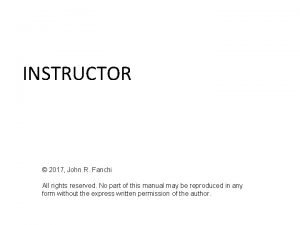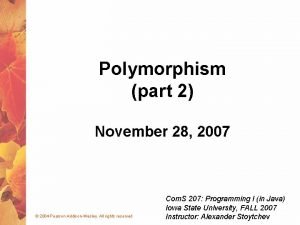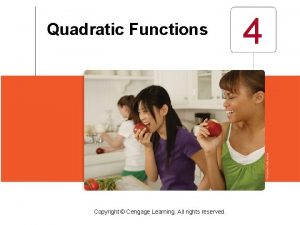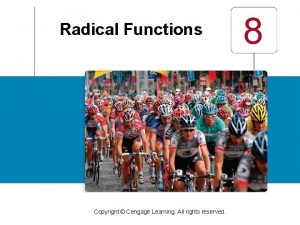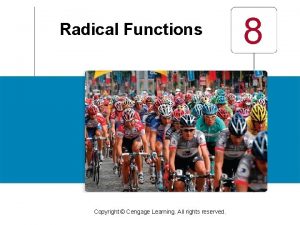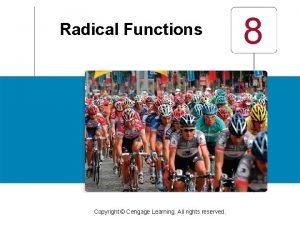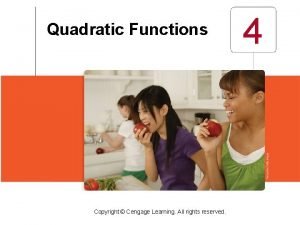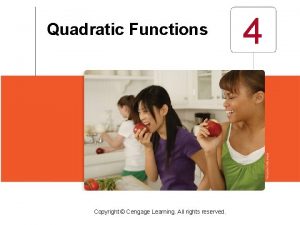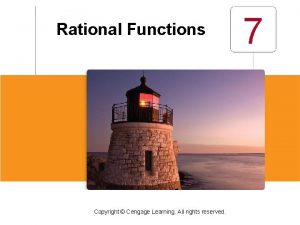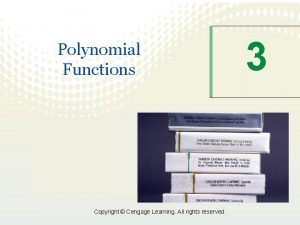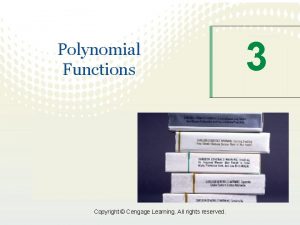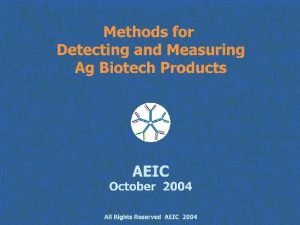2 Functions Copyright Cengage Learning All rights reserved































- Slides: 31

2 Functions Copyright © Cengage Learning. All rights reserved.

2. 7 Combining Functions Copyright © Cengage Learning. All rights reserved.

Objectives ■ Sums, Differences, Products, and Quotients ■ Composition of Functions ■ Applications of Composition 3

Sums, Differences, Products, and Quotients 4

Sums, Differences, Products, and Quotients Two functions f and g can be combined to form new functions f + g, f – g, fg, and f /g in a manner similar to the way we add, subtract, multiply, and divide real numbers. For example, we define the function f + g by (f + g) (x) = f (x) + g (x) The new function f + g is called the sum of the functions f and g; its value at x is f (x) + g (x). Of course, the sum on the right-hand side makes sense only if both f (x) and g (x) are defined, that is, if x belongs to the domain of f and also to the domain of g. 5

Sums, Differences, Products, and Quotients So if the domain of f is A and the domain of g is B, then the domain of f + g is the intersection of these domains, that is, A B. Similarly, we can define the difference f – g, the product fg, and the quotient f /g of the functions f and g. Their domains are A B, but in the case of the quotient we must remember not to divide by 0. 6

Example 1 – Combinations of Functions and Their Domains Let f (x) = and g (x) = (a) Find the functions f + g, f – g, fg, and f /g and their domains. (b) Find (f + g)(4), (f – g)(4), (fg)(4), and (f /g)(4). Solution: (a) The domain of f is {x | x 2}, and the domain of g is {x | x 0}. The intersection of the domains of f and g is {x | x 0 and x 2} = [0, 2) (2, ) 7

Example 1 – Solution cont’d Thus, we have Domain {x | x 0 and x 2} Domain {x | x > 0 and x 2} Note that in the domain of f /g we exclude 0 because g (0) = 0. 8

Example 1 – Solution cont’d (b) Each of these values exist because x = 4 is in the domain of each function. 9

Sums, Differences, Products, and Quotients The graph of the function f + g can be obtained from the graphs of f and g by graphical addition. This means that we add corresponding y-coordinates, as illustrated in the next example. 10

Example 2 – Using Graphical Addition The graphs of f and g are shown in Figure 1. Use graphical addition to graph the function f + g. Figure 1 11

Example 2 – Solution We obtain the graph of f + g by “graphically adding” the value of f (x) to g (x) as shown in Figure 2. Graphical addition Figure 2 This is implemented by copying the line segment PQ on top of PR to obtain the point S on the graph of f + g. 12

Composition of Functions 13

Composition of Functions Now let’s consider a very important way of combining two functions to get a new function. Suppose f (x) = and g (x) = x 2 + 1. We may define a new function h as h(x) = f (g (x)) = f (x 2 + 1) = The function h is made up of the functions f and g in an interesting way: Given a number x, we first apply the function g to it, then apply f to the result. 14

Composition of Functions In this case, f is the rule “take the square root, ” g is the rule “square, then add 1, ” and h is the rule “square, then add 1, then take the square root. ” In other words, we get the rule h by applying the rule g and then the rule f. Figure 3 shows a machine diagram for h. The h machine is composed of the g machine (first) and then the f machine. Figure 3 15

Composition of Functions In general, given any two functions f and g, we start with a number x in the domain of g and find its image g (x). If this number g (x) is in the domain of f, we can then calculate the value of f (g (x)). The result is a new function h (x) = f (g (x)) that is obtained by substituting g into f. It is called the composition (or composite) of f and g and is denoted by f g (“f composed with g”). 16

Composition of Functions The domain of f g is the set of all x in the domain of g such that g (x) is in the domain of f. In other words, (f g) (x) is defined whenever both g (x) and f (g (x)) are defined. We can picture f g using an arrow diagram (Figure 4). Arrow diagram for f g Figure 4 17

Example 3 – Finding the Composition of Functions Let f (x) = x 2 and g (x) = x – 3. (a) Find the functions f g and g f and their domains. (b) Find (f g)(5) and (g f )(7). Solution: (a) We have (f g)(x) = f (g (x)) = f (x – 3) Definition of f g Definition of g 18

Example 3 – Solution = (x – 3)2 and (g f )(x) = g (f (x)) cont’d Definition of f Definition of g f = g(x 2) Definition of f = x 2 – 3 Definition of g The domains of both f g and g f are 19

Example 3 – Solution cont’d (b) We have (f g)(5) = f (g (5)) = f (2) = 22 = 4 (g f )(7) = g (f (7)) = g (49) = 49 – 3 = 46 20

Composition of Functions You can see from Example 3 that, in general, f g g f. Remember that the notation f g means that the function g is applied first and then f is applied second. It is possible to take the composition of three or more functions. For instance, the composite function f g h is found by first applying h, then g, and then f as follows: (f g h) (x) = f (g (h (x))) 21

Example 5 – A Composition of Three Functions Find f g h if f (x) = x / (x + 1), g (x) = x 10, h (x) = x + 3. Solution: (f g h) (x) = f (g (h (x))) Definition of f g h = f (g (x + 3)) Definition of h = f ( (x + 3)10) Definition of g Definition of f 22

Composition of Functions So far, we have used composition to build complicated functions from simpler ones. But in calculus it is useful to be able to “decompose” a complicated function into simpler ones, as shown in the following example. 23

Example 6 – Recognizing a Composition of Functions Given F (x) = F = f g. find functions f and g such that Solution: Since the formula for F says to first add 9 and then take the fourth root, we let g (x) = x + 9 and f (x) = Then (f g) (x) = f (g (x)) Definition of f g 24

Example 6 – Solution = f (x + 9) cont’d Definition of g Definition of f = F (x) 25

Applications of Composition 26

Applications of Composition When working with functions that model real-world situations, we name the variables using letters that suggest the quantity being modeled. We may use t for time, d for distance, V for volume, and so on. For example, if air is being pumped into a balloon, then the radius R of the balloon is a function of the volume V of air pumped into the balloon, say, R = f (V). Also the volume V is a function of the time t that the pump has been working, say, V = g (t). It follows that the radius R is a function of the time t given by R = f (g(t)). 27

Example 7 – An Application of Composition of Functions A ship is traveling at 20 mi/h parallel to a straight shoreline. The ship is 5 mi from shore. It passes a lighthouse at noon. (a) Express the distance s between the lighthouse and the ship as a function of d, the distance the ship has traveled since noon; that is, find f so that s = f (d). (b) Express d as a function of t, the time elapsed since noon; that is, find g so that d = g(t). (c) Find f g. What does this function represent? 28

Example 7 – Solution We first draw a diagram as in Figure 5 29

Example 7 – Solution cont’d (a) We can relate the distances s and d by the Pythagorean Theorem. Thus s can be expressed as a function of d by (b) Since the ship is traveling at 20 mi/h, the distance d it has traveled is a function of t as follows: d = g(t) = 20 t 30

Example 7 – Solution cont’d (c) We have Definition of f g Definition of f The function f g gives the distance of the ship from the lighthouse as a function of time. 31
 Copyright 2015 all rights reserved
Copyright 2015 all rights reserved Copyright © 2015 all rights reserved
Copyright © 2015 all rights reserved Dell all rights reserved copyright 2009
Dell all rights reserved copyright 2009 Copyright © 2018 all rights reserved
Copyright © 2018 all rights reserved Copyright cengage learning. powered by cognero
Copyright cengage learning. powered by cognero All rights reserved example
All rights reserved example All rights reserved sentence
All rights reserved sentence Freesound content licence
Freesound content licence Confidential all rights reserved
Confidential all rights reserved Sentinel-controlled loop pseudocode
Sentinel-controlled loop pseudocode Pearson education inc all rights reserved
Pearson education inc all rights reserved Microsoft corporation. all rights reserved.
Microsoft corporation. all rights reserved. Microsoft corporation. all rights reserved.
Microsoft corporation. all rights reserved. Microsoft corporation. all rights reserved
Microsoft corporation. all rights reserved Pearson education inc. all rights reserved
Pearson education inc. all rights reserved Warning all rights reserved
Warning all rights reserved Siprop
Siprop Quadratic equation cengage
Quadratic equation cengage Warning all rights reserved
Warning all rights reserved Confidential all rights reserved
Confidential all rights reserved Microsoft corporation. all rights reserved
Microsoft corporation. all rights reserved Pearson education inc. all rights reserved
Pearson education inc. all rights reserved 2017 all rights reserved
2017 all rights reserved Copyright 2010 pearson education inc
Copyright 2010 pearson education inc 2010 pearson education inc
2010 pearson education inc Confidential all rights reserved
Confidential all rights reserved Confidential all rights reserved
Confidential all rights reserved R rights reserved
R rights reserved Rights reserved
Rights reserved 2009 delmar cengage learning
2009 delmar cengage learning Chapter 5 learning exercises medical terminology
Chapter 5 learning exercises medical terminology Cengage learning heart diagram
Cengage learning heart diagram



























